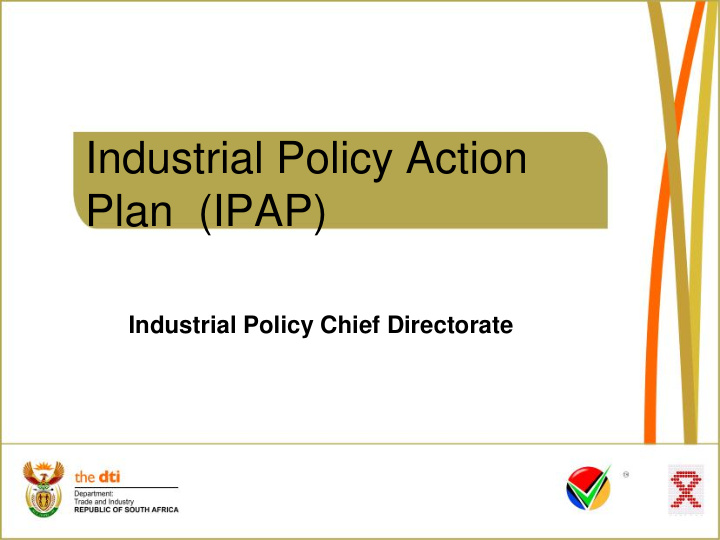



Industrial Policy Action Plan (IPAP) Industrial Policy Chief Directorate
Contents • Economic Context • Rationale IPAP • Factors to Overcome • IPAP Interventions • Transversal Highlights • Sector Highlights • Opportunities
Economic Context • Economic growth has largely been driven by consumption sectors such as finance and insurance, real estate, transport and storage. • Meanwhile key productive sectors like manufacturing and agriculture have contributed far less to the economy than they are potentially capable of doing. • At the same time, South Africa has lost some important manufacturing capabilities • This structural change i.e. from manufacturing to services has played a crucial role in South Africa’s persistent, unacceptably high structural unemployment rates. • Therefore, one needs to address the structure of the economy if one wants to tackle this high unemployment rates.
South Africa’s Industrial Policy (IPAP) • The principal objective of IPAP is to achieve structural change, by encouraging the development, growth and increased competitiveness of the South African manufacturing (Value Added) sector. • Why Manufacturing Value Add ? – Manufacturing Draws in and creates demand for a huge range of upstream inputs and services – It stimulates additional downstream activity in services, maintenance and retail – It is a critical driver of innovation and productivity growth – It is central to the development of a strong export strategy – It has huge employment creation potential for unskilled and semi skilled individuals
Factors to Overcome
IPAP Aims to Address these Factors • Deploying two types of instruments – Cross-cutting or Transversal interventions – Sector specific interventions • Cluster 1 (Interventions since 2007 to date) • Cluster 2 (Qualitatively new areas of intervention) • Cluster 3 (Interventions to develop long term advanced capabilities)
Transversal Interventions
IPAP Transversal Highlights • Public Procurement – In December 2012, PRASA awarded a 10-year contract to build 3 600 coaches to Gibela Rail Consortium - Committed to achieve a 60% local content over the duration of the contract. – Transnet Freight Rail issued an RFP for the procurement of 1064 locomotives as part of its R 300 billion, 7 year capital investment programme. The RFP incorporated a local content requirement of 55% (diesel) and 60% (electric)
IPAP Transversal Highlights • Industrial Financing – Continuing re-orientation of the IDC to finance IPAP/NGP sectors: • R 5.5 billion committed for investment in the Green Economy • R 1.1 billion committed for investment in the agriculture and forestry value-chains • R 501 million approved for the clothing and textiles sector-expected to save 2400 jobs • IDC to lower costs by sourcing R 2 billion from the Unemployment Insurance Fund (UIF), specifically for labour-intensive industries
IPAP Transversal Highlights • Development Trade Policy – Manufactured Exports Tariff Reduction • The Transnet National Ports Authority (TNPA) has committed to changing its pricing model in favour of the export of manufactured goods by lowering tariffs on tradable exports by 40% from 1 April 2013. • Going forward the dti and TNPA have agreed to work together to develop a port pricing strategy that is conducive to industrial development
Sector Interventions: Cluster 1
Sector Highlights Cluster 1 • Auto-motives – Chinese automotive company First Automobile Works (FAW) commences with the construction of a truck plant in COEGA. – Toyota SA opened its new ses’fikile taxi assembly line in Durban, and Africa’s largest parts distribution warehouse – 128 projects approved under the Automotive Investment Scheme (AIS); investments of R 12 billion; incentives of R 3.4 billion; currently sustaining 56 197 jobs
Sector Highlights Cluster 1 • Clothing and Textiles Competitiveness Programme (CTCP) – Since the introduction of the CTCP, the employment decline has halted and more than 12 205 new decent permanent jobs have been created. – The CTCP is now supporting 49 888 jobs out of a total of 101 511 in the sector – The footwear sector projects an increase in shoes produced from 52 million to 100 million in the next 3 years – More than 469 companies assisted under the CTCP
Sector Highlights Cluster 1 • Pharmaceuticals - Project Ketlaphela – The dti provided the necessary financial support for the commencement of the R 1.5 billion ARV API project, due to start with the construction of a R 105 million pilot plant in Pelindaba. • Metal Fabrication, capital and rail transport equipment – R 200 million was allocated from the National Skills Fund to train 970 new apprentices under the National Tooling Initiative – Continuous engagement between the dti and SOCs about supplier development and localisation has led to significant restructuring at Eskom and Transnet.
Sector Interventions :Cluster 2
Opportunities (Cluster 2) • Green and Energy Saving Industries – Electricity and capital-intensive resource processing sectors will have to introduce cutting-edge mitigation technologies and processes and make additional investments into green technologies • Downstream Minerals Beneficiation – South Africa is rich with mineral deposits yet we have not developed the capabilities to add value to these resources. In our drive to developing our capabilities there potential for investors to target specific areas in the value chain. • Upstream Oil & Gas – Given the offshore Oil & Gas activity around both the West and East coasts of Africa. The dti together with TNPA are developing a Ports strategy with the objective of positioning SA as world class Oil & Gas servicing hub
Sector Interventions Cluster 3
Opportunities (Cluster 3) • Nuclear Energy – The Integrated Resource Plan (IRP 2010-2030) indicates that additional electricity generation capacity (9,6 GW) will come from nuclear power. There is an opportunity to develop a local nuclear industry in conjunction with foreign investors. • Advance Manufacturing/Technological Development – To remain competitive firms are continually looking to innovate. To innovate firm’s require strong R&D capabilities. This is another area for Co-operation between firm’s from different countries • Regional Integration – Developing regional Value Chains – Access to a bigger regional market
Thank You
Recommend
More recommend